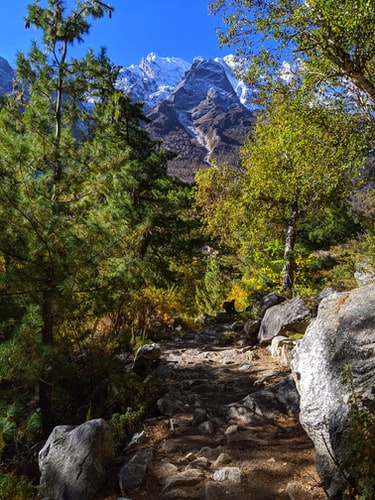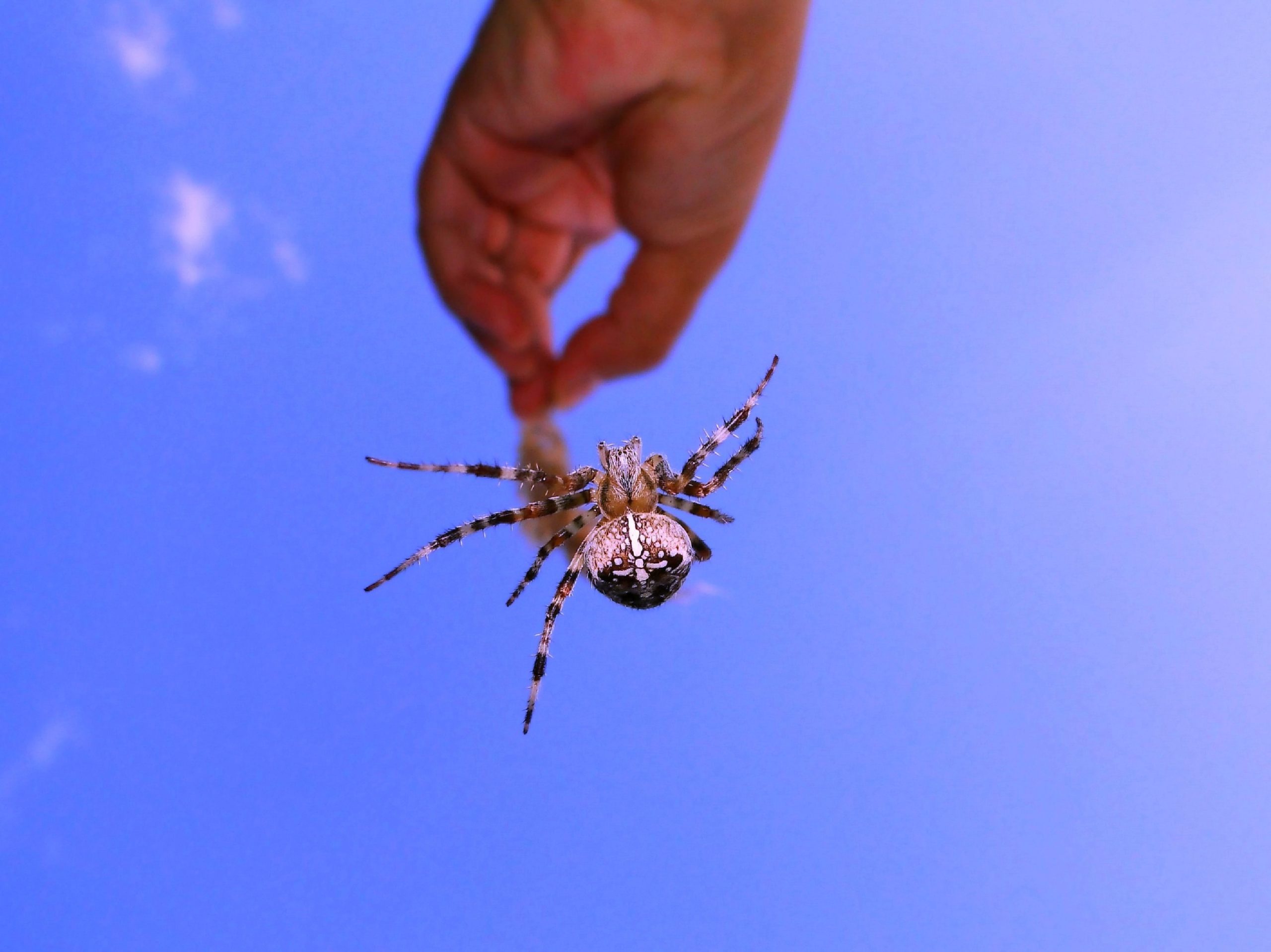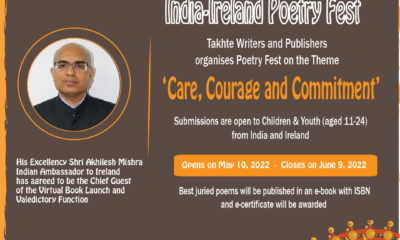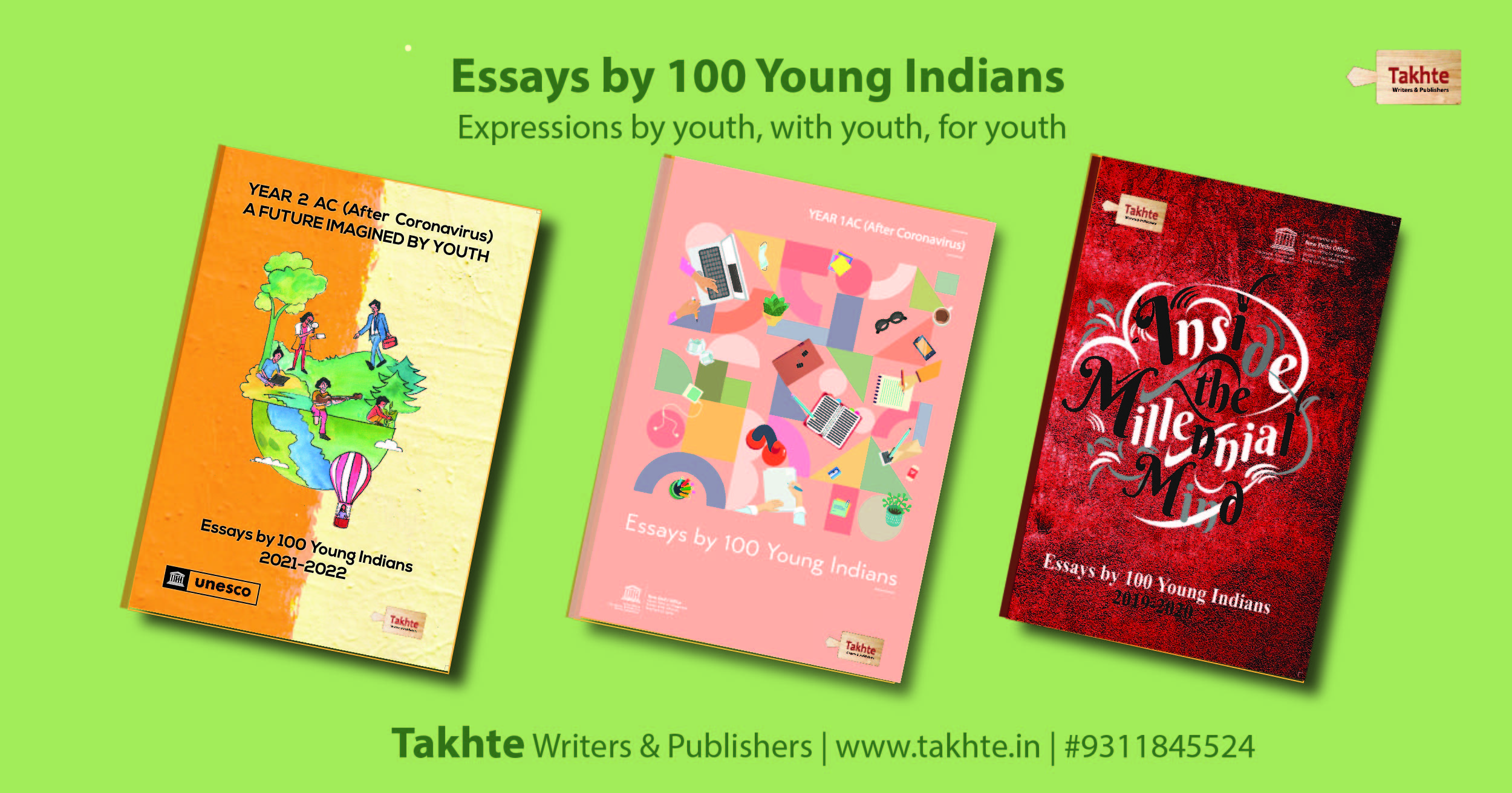Nature’s Lap
When We Met the Deodars

Devika Singh
Delhi Public School, Sector-45, Gurugram
The whitewashed house curved like a Spanish dream with green doors and a single wind chime in the veranda. The taxi driver tilted his head back, and I could tell he was quite proud of his homegrown Mussoorie mind maps although I still claim much credit was due to some of the older locals. Even now, as a young adult, I cannot quite believe the charm of such a cottage appealing to one of the world’s most famous authors. But charming it was, with the deodars looking on as dignified faerie sentinels to the house that seemed a most cherished child of earth, far away from the rest of all of us.
‘How long must I wait?’ the driver now took the whole affair in his prestige, “I haven’t got all day, madam and sir’, this last part directed to my equally flabbergasted parents. Though, all the curiosity of seven whole years, my brother looked at it all as he would at any great monument. All of my spirits seemed to squeal giddy out of my body with every step to the gate and up the stairs. I can remember the door’s exact green because I bored my eyes into it after ringing the bell and when it was swung open by his son, I let my father do the talking. I chimed in with some quips of politeness, but I couldn’t tell you what I’d said any more than I could gather my nerves back then.
‘I’m afraid you’ve caught us on a bad day. He isn’t feeling his best, ‘said his son, ‘although he’s humbled that you’ve come from Delhi. I might get you a signature though; do you have a piece of paper?’
The little travel journal now sits in my closet, encasing all my childish poetry and whatnots, but a single page was torn out to be glued in my diary. I wondered if the trees had disapproved of my absurdly sudden visit. I wished their family the best and looked at stilted rooftops near Domo’s café a little differently. Or perhaps, a little more similar to how Ruskin Bond lived it.
*****
My mother, our designated guide to all the sunset points in Mussoorie, named the next destination to mark the evening’s end. This particular attraction brought on a passionate monologue from our driver. The soliloquy was very welcome if not polished but are not all good things, incredibly joyful when spoken of with careless warmth?
“Brilliant choice, madam, Char Dukan is famed for its sunsets and its chai, all the same, you’ll see this great spiralling white structure that kisses the sky but don’t climb it, any of you who may have vertigo; a big, black telescope too but I’m afraid it stopped working some years back. I know the man who owns it, of course. But do you know how it came to be so important at all? Not many people know, I’m sure otherwise I’m sure it’d be more crowded all year round.”
Mother knew, of course. There was less she didn’t; though she let our self-anointed guide have the honour of shocking us all. My father whipped his head back at us three in the faux leather seats so violently; the ramshackle little black car was veered sideways by the blindsided driver. The commotion was certainly not helped by the seven-year-old screeching at the top of his lungs.
“Sachin Tendulkar? The Sachin Tendulkar? I can’t believe we’re on the road he must’ve driven on.” “He spent his childhood around these trees, and that little shop is quite his personal favourite, so take a good look now, all of you.” And so, we did.
The roads were decidedly the same, as were the mountains but the pinecones hung in the air as if mid-song and the trees looked expectant. It was all the same but entirely new all over again. It cannot be déjà vu if one sees and hears the love of great men echoing off the same cliffs’ valleys. Then beauty cannot be in the eye of the beholder, but rather in lapping thoughts of all whom we meet and admire. Science proclaims your centre of gravity moves with motion and the roads winding uphill atop the green Mussoorie peaks give a heart lurching jump which may be thus explained.
We reached the quaint shop and the telescope, a few meters away from it. It nestled among the clouds but was no different from other beautiful scenic routes I’d seen before. But there was that there, in the easy laughter of the school children and the smiling men and women, the quintessential personality belonging to the ground itself; before that, I associated such silent loudness of a place only in my own beloved Delhi. Mussoorie was, from that moment on, a topsy-turvy labyrinth of hotels, greens and naked rock. It was a shy, new home.
Nature’s Lap
Mother Earth wants her answers

Students of Alpine Public School Nalagarh
Mother Earth gives her gift to all to share.
She gave it freely, yet she was aware,
Things are changing, perhaps for the worse.
How much more can she give if our future is cursed?
It’s way past time to put Mother first,
To clean up the water before the end,
To clean up the air before my lungs sicken,
To renew the soil and feel it quicken
How long until the point of no return?
How much longer until we all finally learn?
To accomplish this task, we all must rise and
stop abusing Mother Earth before she dies and drops
The time to take action is now.
To restore what’s been damaged in some way
We stand on a brick of “too late,” but there’s still time to change our fate.
Kritika Bhadouria
Alpine Public School Nalagarh
Class: 10-D
I am the Earth
I am the Earth.
I am mother earth,
I am the one who gave you birth.
To everything that lives,
The beauty of each one
Gives.
I am the giver of earth,
I am the one who gives you water, soil, air, and the sun.
But in return, you give me pain.
Still, I am quiet.
I am your mother.
and you are my child.
I am an Earth,
I am the one who gave you birth.
Save water and plant a tree.
Let us make a wonderful home for you and me.
Leave the fire,
and leave the ice,
All of these are
unmindful desires
I am an earth; I am the one worth.
Don’t throw the waste away.
and fill me with filth.
Make use of it and recycle it
I am the Earth,
I am the one who gave you birth.
Prashant Singh
Alpine Public School Nalagarh
Why are you destroying me?
Why are you destroying me? I am your mother earth.
Why are you polluting me when you don’t know my worth?
Your life is impossible if I don’t give you land for birth.
Then why do you ruin me for your personal growth?
Because of your foolishness, such circumstances came into my beautiful world.
You cut down all the trees and pollute this paradise-like world.
You capture all the creations in your zoo’s world.
You started hunting animals and started ruining their world.
Please stop pushing up greenhouse gases and don’t make me lose my essence.
Let’s plant together and make me a paradise.
Sakshi
Alpine Public School Nalagarh
Class-10-D
Photo courtesy Evgeni-Tcherkasski-Unsplash.jpg
Nature’s Lap
Arthropods and Anthropos

Yazhini Sathiamoorthy
Stanes School ICSE/ISC, Coimbatore, Tamil Nadu
My ignorance in the kitchen resulted in me being given more interesting things to do, such as plucking curry leaves for cooking. The plants were a little away from our house on the farm and the journey by foot to get a bunch of curry leaves is an exciting one. A curry-leaf errand or not, that place is one of my favourite haunts!
With my eyes scanning my path and the tree trunks around, I reached my destination. As I started plucking, I saw some pairs of eyes directed at me. The ‘some pairs of eyes’ did not belong to different creatures; they belonged to someone with four pairs of legs. Yes, a spider! It was a Two-striped Jumping Spider, about the size of a five rupee coin. I carefully plucked the slender branch on which it was sitting. The spider moved around a little bit, going under one of the leaves and then coming up again. Now, it seemed to be looking at my hand, which was holding the bunch of curry-leaf branches.
“If you want to live and thrive, let the spider run alive.” – Spanish proverb.
The spider which was in my custody is infamous for totally wrong reasons. There are several WhatsApp forwards on the Two-striped Jumping Spider, which often resurfaces, claiming that this Indian spider, now all over the world, has a venomous bite that can kill humans. Such false news leaves both arachnophobes and arachnologists in distress. The very same spider was with me. It is a non-dangerous spider and its bite can cause no significant harm to humans.
Why are some people so afraid of spiders and insects? Before that, let’s clarify certain stuff first. Spiders are not insects. Spiders and scorpions fall under Class Arachnida while butterflies, moths, cockroaches, ants, beetles, bees and wasps (all having three pairs of legs) comprise Class Insecta. Centipedes and millipedes form Class Myriapoda and Class Crustacea primarily consists of crabs. All of these classes together form Phylum Arthropoda.
So, going back to my initial question and amending it: Why are some people afraid of arthropods? Is it because of the extra number of legs? Is it because they bite or sting? Noted historian Yuval Noah Harari says in his book Sapiens that we humans (or Anthropos) started disliking arthropods ever since the advent of agriculture. The Agricultural Revolution made us examine arthropods and many other creatures through the lens of suspicion. Some of them are nasty pests, of course, but many of them are harmless and some immensely helpful. Nonetheless, we had decided to shun most of them.
Several arthropods deserve to be disliked anyways. Take mosquitoes for instance. Some mosquitoes don’t let us sleep peacefully at night and others drive us crazy during the day. There are more serious reasons too: Mosquitoes are the world’s deadliest animals for humans because they are vectors for malaria, dengue, chikungunya, filariasis and so many other diseases. One of the United Nations’ Sustainable Development Goals is to “end the epidemic of malaria in all countries by 2030.” Houseflies are considered enemies to public health and arachnids like ticks and mites are responsible for spreading zoonotic diseases like the plague from livestock to humans. Lice and bedbugs are abominable ectoparasites. Many arthropods are dreadful agricultural pests and the locust invasions in 2020 have left us in no doubt of that. According to the Food and Agriculture Organisation (FAO) of the UN, 20-40% of global crop production are lost to pests (including nematodes and other pathogens apart from arthropods). For many, just a cockroach in the house is the last straw. “Why do these creatures even exist?” one might ask in disgust.
“If all mankind were to disappear, the world would regenerate back to the rich state of equilibrium that existed ten thousand years ago. If insects were to vanish, the environment would collapse into chaos.” – E. O. Wilson.
Just like there are heroes and villains among humans, there are heroes and villains among our arthropods too. Even mosquitoes are not altogether bad as they serve as pollinators and as food for many other animals. But since we need to control the population of mosquitoes, we should switch to insect-friendly methods of doing so. Damselflies are insects that resemble dragonflies but are different. The former close their wings when perched while the latter keep their wings outspread. Now, these damselflies live near lakes, feast on mosquitoes and are good pollinators too. Similarly, ladybugs feed on nasty agricultural pests like aphids. Farmers buy them by the sack and release them in their fields for their bio-control services. Spiders are very decent murderers that keep the populations of many insects under control. Even the much-despised cockroaches curb the spread of many bacterial diseases by eating leftovers. Some scientists say that it would be better for Earth if humans consume insects instead of meat. But I suppose it would take a long time before many of us accept this idea.
We can never be grateful enough to bees, wasps and hoverflies (which mimic bees and wasps but cannot sting). Plants account for the highest biomass on Earth and they certainly owe this to arthropods, especially pollinators, which have the highest biomass in the Animal Kingdom. So many creepy-crawlies: does that sound scary? The sad fact is that arthropods are facing a huge threat from Anthropos. Now, this is scary.
When was the last time you heard an insect-orchestra, the sounds of crickets and cicadas? How many butterflies did you spot during the past week? Maybe you did not notice them but people, scientists and researchers who have been observing and studying them say that they are in peril. All animals, including arthropods, are being marooned due to forests getting converted into farms and then into cities. What’s worse here is that we have very limited data on arthropods. So, we don’t even know the rate at which they are disappearing, but scientists warn that it is pretty rapid.
Not only that but the creatures we particularly find repulsive are expected to multiply because global warming or rise in temperatures favours insects. It is feared that mosquitoes would increase manifold and lead to a 100% rise in deaths due to malaria in sub-Saharan Africa. Agricultural areas might end up swarming with locusts, instead of bees. Climate change might also lead to the evolution of more aggressive spiders. That is true, bad news.
“Teaching a child not to step on a caterpillar is as valuable to the child as it is to the caterpillar.” – Bradley Millar.
I would also say that teaching kids and adults alike to stop fearing arthropods and to start observing them instead is beneficial for arthropods, Anthropos and the Earth. I have seen that people who are frightened of arthropods are too frightened to even approach them and people who are not are just brave enough to squish them. I was really scared of insects when I was small, so much that I thought twice before touching the photograph of a centipede or a spider in an encyclopaedia! Now, I am hunting for field guide books on arthropods.
But before talking about identification guides, people with entomophobia (fear of arthropods) would want to get rid of their fear first. So here is a list of stories/poems/books which helped me find my inner entomophile (someone who likes insects)! Most of them are for children but can be ice-breakers for anybody willing to redefine their relationship with these much-misunderstood creatures.
- James and the Giant Peach is a classic story by Roald Dahl with quirky illustrations by Quentin Blake. “… He was beginning to like his new friends very much. They were not nearly as terrible as they looked. They weren’t terrible at all. They seemed extremely kind and helpful…” This is exactly how one would feel while reading this book through James’ eyes. James is an orphan who is also scared of creepy-crawlies, but he very soon learns about them, from them, by making friends with them. Someone with a keen interest in biology might find factual errors. Nevertheless, Roald Dahl gifts these creatures charming personalities in this book.
- The Big Race by Ruskin Bond is a part of the collection The Road to the Bazaar. Short and crisp, this story is about a ‘beetle-race’ organised by a bunch of ambitious kids. “Koki gazed in rapture at the new beetle – or was it a cockroach? She stroked its back with her thumb. The insect didn’t seem to mind.” Well, not everybody might like the idea of catching beetles and racing them against one another but it is undeniable that Ruskin Bond makes apt observations and passing mentions of many animals in most of his stories.
- Just Like a Bug by Anushka Ravishankar is the third book in the Zain & Ana series with enchanting illustrations by Shilo Shiv Suleman. It features the following characters: Zain and Ana who are not interested in insects but become entomophile in the course of the story, Gopi, their new-found friend who is an entomophile aspiring to become an entomologist, Dr Dhondy, a mysterious man who is an entomologist himself and of course, lots of insects including ants and butterflies. The children’s observations, plans and predictions are a treat to read!
- Charlotte’s Web is a touching story by E.B. White, illustrated by Garth Williams and published in 1952. Charlotte is a spider who does everything she can to save Wilbur, a pig from being slaughtered. I owe letting go of my fear of spiders to this book. After reading this, probably every spider sitting on its web with an egg sac would remind one of Charlotte.
- Song for a Beetle in a Goldfish Bowl is a funny yet thought-provoking song for a beetle in a goldfish bowl again by Ruskin Bond. The poem conveys his thoughts and actions towards the beetle and its pitiable condition in a subtle way, with a foot-tapping rhythm.
- Jungle Folk is a humorous and informative account of Indian birds by British naturalist Douglas Dewar, first published in 1912. Although critters are not in the spotlight in this book, one almost feels bad for them, especially for the spiders through Dewar’s arresting style. No spoilers here!
- God of Small Things, as you might already know and even have read, is Arundhati Roy’s Booker-prize-winning 1997 novel with “furred moths and icy butterflies.” Full of graphic observations of life including smaller forms on which the story heavily relies, the author has described nature in an unpolished way. The twins’ grandfather being an Imperial Entomologist caters to our interest here. Although sometimes, the scene takes a grotesque turn as when Rahel smashes a small army of ants with a stone, just for fun.
- The Ants and the Pen is a picture book by Irdies Shah illustrated by Prashant Miranda, which explores the explorations of a troop of ants. Giving it a read will surely brighten up your day.
Once one stops being afraid of spiders or grasshoppers or whatever, the rest is easy; critters turn out simply too interesting to be ignored. The world can have enough entomologists and arachnologists (and lepidopterists and myrmecologists and acridologists, the list is so long) only when we start making friends with our amazing arthropods.
I walk back home holding the bunch of curry leaves and the precious Two-striped Jumping Spider on it.
“It took you so long,” my mother said.
“Yes, because I found this little guy on that plant. Look.” I replied, showing the spider to her and then proceeding to leave it on another plant.
“Fine,” she said, “Will you also get me some green chillies from there?”
“Sure, why not!” I grinned.
Nature’s Lap
Tracing Our Roots

Devika Bajaj
The Shri Ram School Aravali, Gurugram, Haryana
It would be judicious to say, nature is unequivocally our most potent source of inspiration to learn, innovate and discover solutions. As history bears testimony, many revolutionary ideas and inventions were successfully emulated from our environment. We were able to benefit and overcome complex challenges through its applications significantly. Some of the best examples to understand the concept of biomimicry are that of aeroplanes modelled after birds and flight, supersonic trains imitating kingfisher birds and bionic cars designed like the boxfishes amongst others.
While the systematic approach of ever-evolving science and technology is crucial to saving our planet, the role of our culture and other multidisciplinary subjects are significant too. To build a resilient eco-system, it is essential to understand the reciprocal relation of humans with other organisms and nature in general.
Approximately 4.5 billion years ago, mother Earth was created. It is incredible to think that the only known planet to foster life in the vast galaxy was created out of swirling masses of dust, rocks and gases. Over the period, Homo Habilis evolved into a species, as they possessed unique attributes like none others. Gradual evolution resulted in us, acquiring complex reasoning abilities and superior skills. We surpassed all creatures with the ability to adapt due to our unique emotional and intellectual quotient. However, as we fast forward to the present, we realize that we have been rather self-centred towards our interests. In turn, it has rapidly resulted in the deterioration of the environment and imbalances in the ecosystem.
Although the transition from wilderness to prosperous farmland and meticulously planned cities have been advantageous, it is undoubtedly a boon as well as a bane! Rapid urbanization due to ever-evolving technology has wholly disrupted our focus of living in harmony with nature. Sadly, we continue to plunder our natural resources at a breakneck speed. Also, the rise in harmful anthropogenic activities continues to raise carbon emissions at an alarming rate. The detrimental effects of these pollutants are not only making our planet hotter but are the leading cause for the long- term climate changes. Over our existence in the last few centuries, we have forgotten that mutual symbiotic relationship with our environment cannot be one-sided.
One can wonder in amazement over the lack of panic about the dire ecological threat, as we have witnessed in the case of the ongoing pandemic. No doubt the novel Coronavirus continues to cause massive human devastation in the absence of a suitable cure. The wealthiest nations with trillions of dollars at their disposal are seen scrambling in the race to develop efficacious drugs and vaccines to arrest the spread. However, Global Warming and its deadly consequences cannot be treated lightly either. It is shocking yet true that air pollution alone claims 7 million lives annually. It is projected that over one-third of animal and plant species will be extinct if the current trajectory of greenhouse gas emissions remains unabated. While the authorities may have adopted stringent measures to ban the exploitation of land, forests and other non-renewable resources, it continues to justify economic development over sustainable practices.
If we retrace our roots, it is evident that the indigenous communities in the past were more resilient and integrated with the natural world. More than three million years ago, our ancestors or Hominids evolved on earth. Although they were exceptional survivors, many species became non-existent and only Homo Sapiens overcame extinction due to their high endurance. Over time, farming and domesticating livestock replaced high dependence of hunting animals and gathering plants. Despite harsh and dynamic habitats, their adaptability to embrace their environment without burdening it was ingenuous. One of the best practices they adopted was frugality and zero waste, which was, in most part, biodegradable. Also, small settlements displayed a deep connection with nature in the absence of any predominant religion. They worshipped and celebrated different natural phenomena, fearing their wrath to observe many myths and rituals. Perhaps we should be thankful to our ancestors for protecting our environment by advocating practices of veneration to rivers, animals, trees and other sacred plants.
From time immemorial, culture along with traditions has played an intrinsic role in nurturing our belief that, nothing is lost, nothing is created, everything is transformed in nature. There is documented proof that different spiritual beliefs have unanimously preached that mother Earth should be revered and respected. Across the diversity of major religions in the world, each converges to propagate the universal notion of protecting the environment as endorsed by their faith. While our lineage indeed defines our allegiance to a particular religion, our association is mostly dependent on our perception of belonging and righteousness.
While there are countless systems of belief, there are four oldest adherences, popularly referred as world religions. They propound environmental guidance within their unique framework. With the most massive followers in the world, Christianity is further divided into Catholics and Protestants.
Jointly they urge their devotees to care and protect every creation of God morally. Jesus encourages its followers to embrace environmental solidarity and lead their life most sustainably. Their holy book Bible edifies that we cannot possess or stake our claim on nature. It further asserts that a good steward is who is accountable and responsible for the preservation of Earth and all its natural resources. To endorse this thought, the example of Tamil Christians would be quite apt. With agriculture as their primary means of livelihood, the locals believe and perform many ecological traditions and cultural practices to appease their God and ensure satisfactory yields. It is common for people of this sect to observe varying rituals for rain and associate mother Mary with mother Earth. Similar to many other religions, the Catholics strongly believe in worshipping certain trees for their therapeutic benefits and their ability to ward off evil.
A popular movement Tarumitra meaning friends of trees is another instance to educate and create awareness on the alarming rise in tree felling. In other parts of the world, the church has actively condemned harmful human activities and acted decisively in many ongoing campaigns. Few noteworthy examples range from, A Rocha, established in 1983 in Portugal to the most recent encyclical Laudato Si written by Pope Francis.
Growing at a tremendous rate globally, Islam is currently the second-largest religion in the world. It is monotheistic, just like Christianity and Judaism. The Muslims believe in Allah or the lord of the world and Muhammad as the final Prophet. Most of them religiously offer Salat or prayers five times a day. Their holy scripture Quran regards all humans or khalifas as protectors of Mother Earth and hold each one accountable for their actions. It is said, the holy book contains more than 200 verses on an environment which emphasizes that there is nothing more Islamic than taking care of our planet, which is God’s most precious creation. One of the principal ideologies mandated by this faith is in planting and nurturing trees. In the vast dessert of North Jordan, one can still witness the lone tree, which had sheltered the Prophet when he was a child! Furthermore, it reinforces the scientific concept of the chain of life where each organism is dependent on another.
One of the most famous instances of Islamic Fatwa was passed by the clerics of an Indonesian mosqueto protect endangered animals. Consequently, another organization was able to successfully convince the local fishermen in Tanzania against unethical fishing practices. Some of the famous Islamic environmentalists who have been internationally recognized for their efforts are, Late Ayman Ahlawal, Fazlun Khalid, Nana Firman amongst others.
More than four thousand years back, the third-largest religion-Hinduism,originated with the pure intent to guide people towards a disciplined existence. It is polytheistic, hence does not restrict worship to any one particular god, philosophy or natural power in fact, what truly sets the faith apart is that it attaches greater significance to the moral belief over any depiction of the divine. It lays great emphasis on environmental ethics of Ahimsa and forbids one from exploiting or destroying nature.
According to the ancient scriptures, there are five facets of life- air, water, fire, space and earth, all derived from nature. It is every Hindu’s dharma to worship different elements representing earth like sun, rainfall, rivers, mountains etc. Moreover, many animals and plants were saved from becoming endangered as they were feared or protected on religious grounds. The tradition to worship trees like- Banyan, Neem, Peepal, Bel, Tulsi amongst others has been an integral part of Hindu traditions since centuries. Similarly, many sacred animals, namely Gau Mata, Kamdhenu, Garuda, are symbols or personification of various gods.
In addition, the vibrant Hindu art and architecture take great pride in their cultural heritage. The beautifully rendered scenes on pottery, paintings and sculptures depict their deep confluence with nature and its elements. The fundamental expression to preserve the environment gave way too many strong superstitions, myths, and rituals observed in Hindu culture. One such historical practice which salvaged senseless deforestation was Sacred Groves, where random patches of land were devoted to a deity or local village gods. More recently, Chipko Andolan an ecological movement gained traction in the rural Himalayan region to protest against unprecedented deforestation. Inspired by Gandhian ideals of non-violence, the women of the village clung to the trees to prevent them from felling. The successful ban on green felling made this campaign immensely popular, and many consequent dissents in other regions followed soon after. There are many remarkable initiatives like Save Silent Valley, Appiko Chaluvali and Narmada Bachao Andolan, which set precedence and motivating others.
Buddhism is the fourth largest religion in the world, which was founded more than 2000 years back by Lord Buddha or the Enlightened One. He preached that that environmental crisis can be averted through interdependent yet mutually supportive criterion- behaviour, mind and understanding. The religion has a deep connection with nature, and Bodhi Tree is especially very significant as it embodies knowledge and teaching. Buddha’s doctrines were simple and urged mortals to co-exist peacefully with nature. He considered endangering water bodies and forests a deep sin. Under his guidance, monks of Thailand played a predominant role in practising safe agricultural practices. One of the programs introduced by him to arrest water pollution- Dhamma Yatra for Songha Lake demonstrates his insight and acute concern for the people afflicted then. Lastly, education and religion were considered as crucial components to address the severe consequences of environmental degradation. As the current Dalai Lama said, Earth is our only home, and we have to bridge the gap between the haves and the have not’s.
Over the centuries, humankind has been known to worship nature and its elements as they were considered divine manifestations. While religion, traditions, rituals or belief may set us apart within an organized framework of spirituality. The truth is that despite perceived differences, our fundamental goal remains the same! We need to rekindle our dysfunctional relationship with nature lest we become more vulnerable. We must learn from our past mistakes and make prudent decisions to collaborate as individuals with our community and policymakers. In a nutshell, the environmental crisis is borderless, and only those countries will survive who synergize and follow strict protocols to minimize their carbon footprints.
As David Brower said, “We do not inherit the earth from our ancestors, we borrow it from our children.”
-

 Uncategorized3 years ago
Uncategorized3 years agoOnline Elocution Contest
-

 Legal Talks4 years ago
Legal Talks4 years agoCUSTODIAL RAPE IN LIGHT OF THE MATHURA GANG RAPE CASE
-

 Poems4 years ago
Poems4 years agoPoems
-

 Poems3 years ago
Poems3 years agoIndia-Ireland Poetry Fest
-

 Legal Talks4 years ago
Legal Talks4 years agoCompliances Relating to the Commercialization of Electronic Devices
-

 Art & Culture4 years ago
Art & Culture4 years agoThe Lore of the Days of Yore: Significance of History
-

 Legal Talks4 years ago
Legal Talks4 years agoPrivacy Laws & Consent while using Image of Random People Clicked on Street for Facial Recognition
-
Short-story4 years ago
Bibek’s visit at his friend’s bungalow














